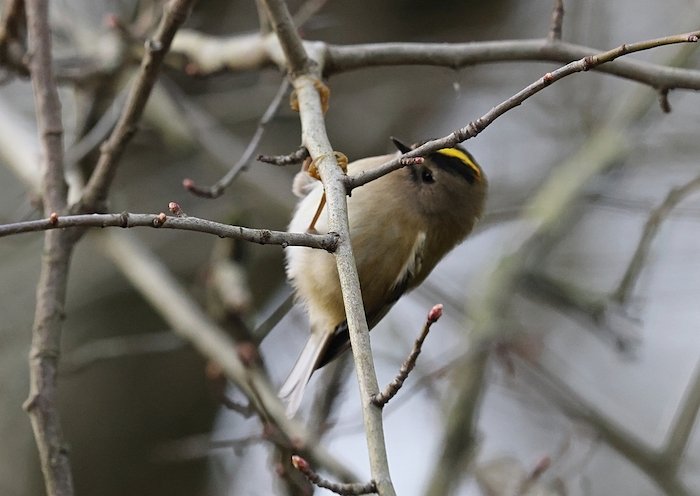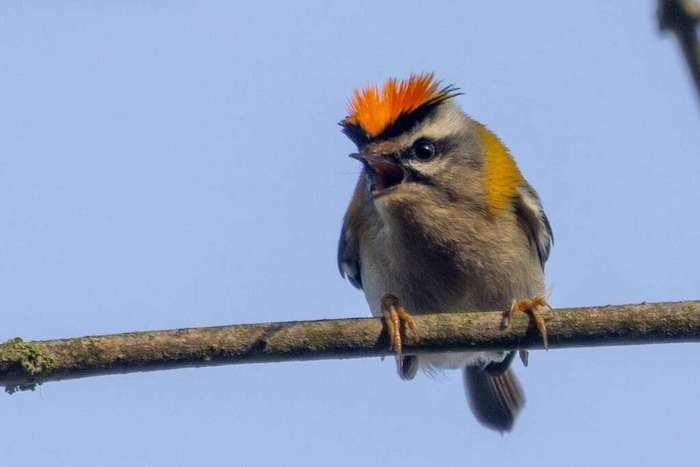Fit for a King
Observation by Alexis Lours, CC BY 4.0, via iNaturalist
Regulidae
on March 26, 2024Hey kids, welcome back to our series on the mysteries of created kinds.
Last week, we met a group of yodeling birds. This week, we continue with the bird theme, but there are no more yodels and no more swimming (unless you count the odd birdbath).

This kind is migratory and has a large, widespread range from the island of Madeira in the North Atlantic to Taiwan in the South Pacific. They build up reserves of fat before they migrate. The less fat they store, the greater their risk of illness on the trip.1 After long strenuous trips, the birds have to rest and restore their body fat before continuing their migration.2 Different populations have different song dialects, allowing them to be easily tracked to their sources during migration.3 They are insectivores, munching on insects that they often capture while hovering above a branch of a tree. They change this method when food is scarce to something that uses less energy.4
Some members of this kind exhibit sexual dimorphism, with males and females having at least slight differences in coloring. The difference often is displayed in the colorful crown that all but one member of this kind display. Usually, the males have a more colorful crown or an additional color the females lack.
Has anyone figured it out yet? This week’s kind is the Regulidae—the kinglet kind. The ruby-crowned kinglet is common in large parts of the United States. You may have them in your backyard. Stay tuned for next week when we move to South Africa looking for a small group of toads.
Try out this fun crossword!
Clue
Your clue for the week is:
Many of these toads are tiny, maxing out at less than two inches. You often find them at higher elevations.
Ask a Question
Have you ever had a question about created kinds but didn’t know who to ask? Have you ever wanted to learn more about your favorite kind? Well, now you can! You can ask me, Inspector Barry Mins, a question! Have your parents help you fill out this form, and you might get your question answered in my column! If you have any questions about created kinds, feel free to send them my way!
Footnotes
- J. Merila and E. Svensson, “Fat Reserves and Health State in Migrant Goldcrest Regulus regulus,” Functional Ecology 9, no. 6 (1995): 842–848, https://doi.org/10.2307/2389981.
- Mats Hansson and Jan Pettersson, “Competition and Fat Deposition in Goldcrests (Regulus regulus) at a Migration Stop-Over Site,” Die Vogelwarte 35 (1989): 21–31, https://cdn.birdlife.se/wp-content/uploads/message_series/cms_14-s1_116.pdf.
- Lily A. Douglas and Edward R. Pandolfino, “Using Song Dialects to Reveal Migratory Patterns of Ruby-Crowned Kinglet Populations,” Journal of Field Ornithology 94, no. 3 (2023): https://journal.afonet.org/vol94/iss3/art10/.
- Rolf Ake Norberg, “Test of Theory of Foraging Mode: Goldcrests, Regulus regulus, Forage by High-Yield, Energy-Expensive Hovering Flight When Food Is Abundant but Use Low-Yield, Low-Cost Methods When Food Is Scarce,” Ecology and Evolution 11, no. 23 (2021): 16547–16561, https://onlinelibrary.wiley.com/doi/pdfdirect/10.1002/ece3.8205.
- © 2024 Answers in Genesis
- Privacy Policy
- Contact
- About





